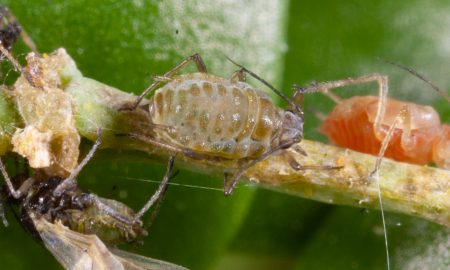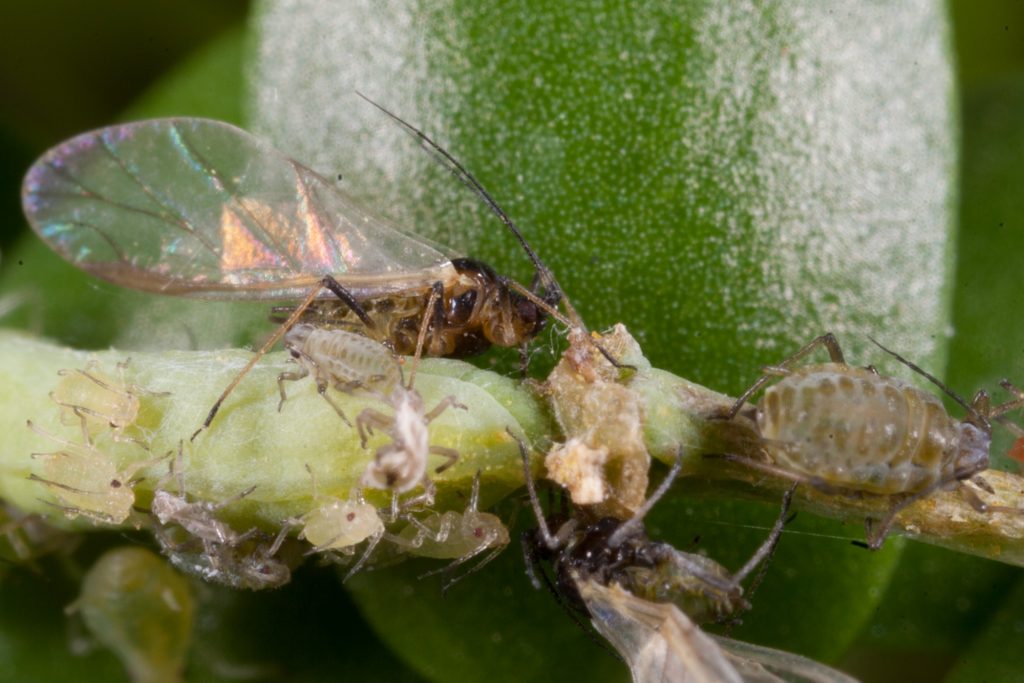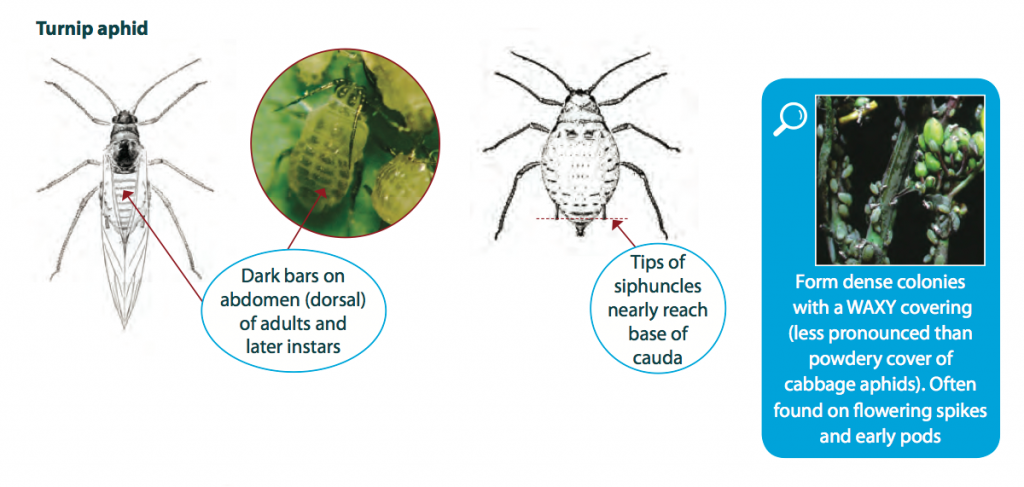Turnip aphid
Lipaphis pseudobrassicae

Wingless turnip aphid adult. Photo by Andrew Weeks, Cesar Australia
Summary Top
The turnip aphid is a common and widespread aphid species that forms clusters on canola flowering spikes in spring. Colonies are covered in a light waxy substance. Turnip aphids are known to transmit several plant viruses that can contribute to yield losses, including beet western yellows virus, cauliflower mosaic virus and turnip mosaic virus.
Occurrence Top
Turnip aphids are common pests of canola and other cruciferous forage crops in many parts of Australia. They are widely distributed and have previously been recorded in Queensland, New South Wales, Victoria, South Australia, Tasmania and Western Australia. Populations generally peak in late winter and spring. Turnip aphids are common in districts or seasons with warm, dry weather.
One of several aphid species commonly found attacking canola and other cruciferous crops
Description Top
Aphids are a group of soft-bodied bugs commonly found in a wide range of crops and pastures. Identification of crop aphids is very important when making control decisions. Distinguishing between aphids can be easy in the non-winged form but challenging with winged aphids.
Turnip aphids grow up to 3 mm long and have an olive to greyish-green coloured body with dark bars on the abdomen. Adults can be winged or wingless. Nymphs are similar to adults but are smaller in size and do not have wings.


Lifecycle Top
Winged aphids fly into crops from wild radish, wild turnip and other cruciferous plants, and colonies of aphids start to build up within the crop. Aphids can reproduce both asexually and sexually however in Australia, the sexual phase is often lost. Aphids reproduce asexually whereby females give birth to live young. Mature females can produce many generations during the growing season.
Temperatures during autumn and spring are optimal for aphid survival and reproduction. During these times, the aphid populations may undergo several generations. Populations peak in late winter and early spring; development rates are particularly favoured when daily maximum temperatures reach 20-25°C. These temperatures give rise to dense colonies on flowering spikes. Turnip aphids are more susceptible to cold weather than cabbage aphids. Development will cease or slow if temperatures fall below 9°C.
Nymphs, which do not have wings, go through several growth stages, moulting at each stage, before becoming adults. When plants become unsuitable or overcrowding occurs, winged aphids, called alates, develop and migrate to other plants or crops.

Behaviour Top
Turnip aphids form dense colonies usually around growing tips. These colonies are typically covered with a fine wax; this is not as obvious as that on the cabbage aphid.
Similar to Top
Other aphids, in particular the cabbage aphid and green peach aphid.
Crops attacked Top
Predominantly canola, but also other cruciferous forage crops. Alternative weed hosts include wild radish and wild turnip.
Damage Top
Direct feeding damage:
Turnip aphid infestations start when winged aphids fly into crops from autumn weeds. They are most prolific in autumn and spring when the warm weather enables them to rapidly multiply.
Adults and nymphs suck sap from plants and high numbers can result in reduced yield by reducing pod set, pod fill and grain quality. Colonies on leaves often become evident by the distortion and discoloration (yellowing) of infested parts. Canola is most sensitive to aphid damage during bud formation through to late flowering. Secretion of honeydew by aphids can cause secondary fungal growth, which inhibits photosynthesis and can decrease plant growth.
Indirect damage (virus transmission):
Turnip aphids cause indirect damage by spreading plant viruses. Aphids spread viruses between plants by feeding and probing as they move between individual plants and paddocks. The ability to transmit particular viruses differs with each aphid species and viruses may be transmitted in a persistent or non-persistent manner (see below). This influences the likelihood of plant infection.
Turnip aphids transmit many viruses that can contribute to yield losses in canola, including cauliflower mosaic virus (CaMV), turnip mosaic virus (TuMV) and beet western yellows virus (BWYV, syn. turnip yellows virus). These viruses are widespread and surveys have found that in some situations most crops have some infected plants. These viruses are not seed-borne. They survive in weeds or volunteer host plants during the summer and are then spread from these plants into crops by aphids that act as a vector for transmission. Yield loss is greater in crops that have been infected as seedlings. Infections can occur past the rosette stage of canola growth but these often have little effect on yield.
Turnip aphids also transmit cucumber mosaic virus (CMV). CMV is a seed- and aphid-borne virus that infects narrow-leafed lupins and many other broad-leafed plant species. CMV is transmitted non-persistently: an aphid picks it up within one to two seconds while probing an infected plant, but the virus is then lost again when the aphid probes one or two healthy plants.
Turnip aphids can cause damage by transmitting viruses including beet western yellows virus, cauliflower mosaic virus and turnip mosaic virus and by direct feeding when in high numbers.
Monitor Top
Monitor for turnip aphids weekly from late winter onwards, but especially during flowering and grain fill. Aphids will generally move into paddocks from roadsides and damage will first appear on crop edges. Turnip aphids are usually found on the terminal flowering spikes. Aphid distribution may be patchy, so monitoring should include at least five sampling points over the paddock. Inspect at least 20 plants at each sampling point. For disease-prone areas, regular aphid monitoring from autumn onwards is recommended to detect aphids moving into crops, particularly along paddock edges.
Symptoms of virus infections are very variable, from no visual indication, to stunted red plants and stiffening of leaves for BWYV, chlorotic ring spots and mottling for CaMV and yellow mosaic patterning and tip necrosis for TuMV. Autumn is the critical infection period; the earliest-sown crops usually have the highest infection incidence. CMV infection causes lupin leaves to become pale, bunched, and down curled with faint mosaic. In plants that grow from infected seed, all leaves develop these symptoms and these plants are severely stunted.
Aphid infestations can be reduced by heavy rain events or sustained frosts. If heavy rain occurs after a decision to spray has been made, but before the insecticide has been applied, check the crop again to determine if treatment is still required.
Economic thresholds Top
Canola:
• NSW: >50% of plants with clusters 25 mm long on stem or 4-5 stems per m2 with cluster 50 mm long on stems (Hertel et al. 2013).
• WA: 20% of plants infested (Berlandier et al. 2010) OR >10% of plants with >25 mm of stem infested (Berlandier & Baker 2007).
When determining economic thresholds for aphids, it is critical to consider several other factors before making a decision. Most importantly, the current growing conditions and moisture availability should be assessed. Crops that are not moisture stressed have a greater ability to compensate for aphid damage and will generally be able to tolerate far higher infestations than moisture stressed plants before a yield loss occurs.
Thresholds for managing aphids to prevent the incursion of aphid-vectored virus have not been established and will be much lower than any threshold to prevent yield loss via direct feeding.
Management options Top
Biological
There are many effective natural enemies of aphids. Hoverfly larvae, lacewings, ladybird beetles and damsel bugs are known predators that can suppress populations. Aphid parasitic wasps lay eggs inside bodies of aphids and evidence of parasitism is seen as bronze-coloured enlarged aphid ‘mummies’. As mummies develop at the latter stages of wasp development inside the aphid host, it is likely that many more aphids have been parasitised than indicated by the proportion of mummies. Naturally occurring aphid fungal diseases (Pandora neoaphidis and Conidiobolyus obscurus) can also suppress aphid populations.
Cultural
Control summer and autumn weeds in and around crops, particularly wild radish and wild turnip, to reduce the availability of alternative hosts between growing seasons. Where feasible, sow into standing stubble and use a high sowing rate to achieve a dense crop canopy, which will assist in deterring aphid landings.
Sow at recommended times; earlier sown crops usually have a greater incidence of viral infection.
Chemical
The use of insecticide seed treatments can delay aphid colonisation and reduce early infestation, aphid feeding and the spread of viruses.
A border spray in autumn/early winter, when aphids begin to move into crops, may provide sufficient control without the need to spray the entire paddock. Imidacloprid is registered as an insecticide seed treatment against turnip aphids, however there are no foliar sprays registered specifically for this species.
Avoid the use of broad-spectrum ‘insurance’ sprays and apply insecticides only after monitoring and distinguishing between aphid species. Consider the populations of beneficial insects before making a decision to spray, particularly in spring when these natural enemies can play a very important role in suppressing aphid populations if left untouched.
Rotating chemical groups and taking advantage of biological control are essential to extend the useful life of the available chemistries.
Acknowledgements Top
This article was compiled by Paul Umina (cesar) and Sandra Hangartner.
References/Further Reading Top
Bailey PT. 2007. Pests of field crops and pastures: Identification and Control. CSIRO Publishing, Melbourne, Australia.
Bellati J, Mangano P, Umina P and Henry K. 2012. I SPY Insects of Southern Australian Broadacre Farming Systems Identification Manual and Education Resource. Department of Primary Industries and Resources South Australia (PIRSA), the Department of Agriculture and Food Western Australia (DAFWA) and cesar Pty Ltd.
Berlandier FA and Baker GJ. 2007. Winter oilseeds. In: Pests of field crops and pastures: identification and control. (ed. PT Bailey) pp 135-154. CSIRO Publishing: Melbourne.
Berlandier F, Severtson D and Mangano P. 2010. Aphid management in canola crops. Western Australia Department of Agriculture and Food. Farmnote 440.
Blackman RL and Eastop VF. 2000. Aphids on the world’s crops: an identification and information guide. John Wiley and Sons, England.
Coutts BA and Jones RAC. 2000. Viruses infecting canola (Brassica napus) in south-west Australia: incidence, distribution, spread and infection reservoir in wild radish (Raphanus raphinistrum). Australian Journal of Agricultural Research 51: 925–936.
Coutts BA, Hawkes JR and Jones RAC. 2006. Occurrence of Beet western yellows virus and its aphid vectors in over-summering broad-leafed weeds and volunteer crop plants in the grainbelt region of south-western Australia. Australian Journal of Agricultural Research 57: 975–982.
Edwards OR, Franzmann B, Thackray D, Micic S. 2008. Insecticide resistance and implications for future aphid management in Australia grains and pastures: a review. Australian Journal of Experimental Agriculture 48: 1523-1530.
Hainan GU, Fitt GP and Baker GH. 2007. Invertebrate pests of canola and their management in Australia: a review. Austral Entomology 46: 231-243.
Hertel K, Roberts K and Bowden P. 2011. Insect and Mite control in field crops. New South Wales DPI. ISSN 1441-1773.
Gu H, Fitt GP and Baker GH.2007. Invertebrate pests of canola and their management in Australia: a review. Australian Journal of Entomology 46: 231-243.
Jones RAC and Proudlove W. 1991. Further studies on cucumber mosaic virus infection of narrow-leafed lupin (Lupinus angustifolius): seed-borne infection, aphid transmission, spread and effects on grain yield. Annals of Applied Biology 118: 319-329.
Jones R, Coutts B, Smith L and Hawkes J. 2003. Benefits provided by treating canola seed with imidacloprid seed dressing. Agribusiness Crop Updates. Department of Agriculture, Western Australia.
King C, Jacob HS and Berlandier F. 2006. The influence of water deficiency on the relationship between canola (Brassica napus L.), and two aphid species (Hemiptera: Aphididae), Lipaphis erysimi (Kaltenbach) and Brevicoryne brassicae (L.). Australian Journal of Agricultural Research 57: 439–445.
Marcroft S, Potter T and Jones R. 2011. Canola diseases: The back pocket guide. GRDC
Moran N. 1992. The evolution of aphid life cycles. Annual Review of Entomology 37: 321-348.
Schwinghamer M and Schilg M. 2003. The virus situation in chickpeas, faba beans and canola. Proceedings GRDC Update – Dubbo.
Valenzuela I and Hoffmann AA. 2014. Effects of aphid feeding and associated virus injury on grain crops in Australia. Austral Entomology. DOI: 10.1111/aen.12122.
Wratten K. 2002. Viruses in canola in NSW. Proceedings GRDC Update – Wagga Wagga.
| Date | Version | Author(s) | Reviewed by |
|---|---|---|---|
| March 2015 | 1.0 | Paul Umina (cesar) and Sandra Hangartner | Alana Govender (cesar) and Bill Kimber (SARDI) |
What are PestNotes?
PestNotes are information sheets developed through a collaboration between Cesar Australia and the South Australian Research and Development Institute (SARDI). Copyright: © All material published in PestNotes is copyright protected by Cesar Australia and SARDI and may not be reproduced in any form without written permission from both agencies.
Disclaimer
The material provided in PestNotes is based on the best available information at the time of publishing. No person should act on the basis of the contents of this publication without first obtaining independent, professional advice. PestNotes may identify products by proprietary or trade names to help readers identify particular products. We do not endorse or recommend the products of any manufacturer referred to. Other products may perform as well as or better than those specifically referred to. Cesar Australia and PIRSA will not be liable for any loss, damage, cost or expense incurred or arising by reason of any person using or relying on the information in this publication. Any research with unregistered pesticides or products referred to in PestNotes does not constitute a recommendation for that particular use.

